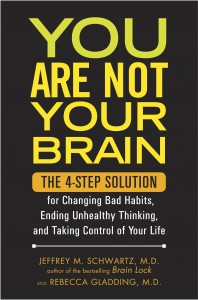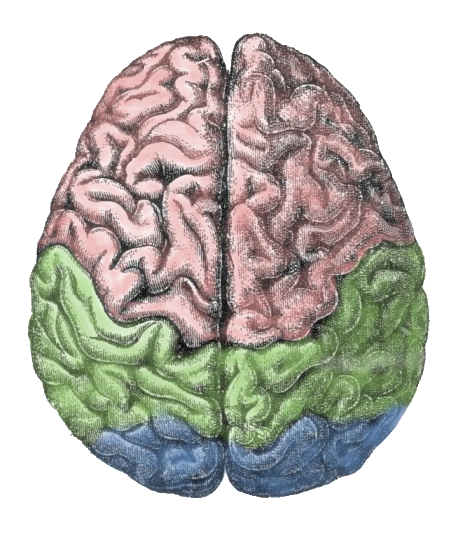You Are Not Your Brain: Book Review
Book Review: You Are Not Your Brain, The 4-Step Solution for Changing Bad Habits, Ending Unhealthy Thinking, and Taking Control of Your Life by Jeffrey Schwartz, M. D. and Rebecca Gladding, M. D.
 You Are Not Your Brain is a brilliant guide to understanding and transforming what the authors call "deceptive brain messages" - our well worn repetitive stories that lead to fear, worry, bad habits, low-self esteem, unhealthy behaviors, stuck patterns, and other dysfunctional impulses, feelings, and actions.
You Are Not Your Brain is a brilliant guide to understanding and transforming what the authors call "deceptive brain messages" - our well worn repetitive stories that lead to fear, worry, bad habits, low-self esteem, unhealthy behaviors, stuck patterns, and other dysfunctional impulses, feelings, and actions.
While it's not groundbreaking news that it's possible to change unhealthy beliefs and dysfunctional habits, most people still find it extremely difficult to do so.
What makes this book stand out is the way the authors - two neuroscience experts - describe in clear, lay person terms the precise brain biology that creates these faulty messages and how the very way the brain functions makes it extremely difficult though not impossible to change them.
Having this knowledge in hand coupled with their well explained set of research-proven techniques, empowers you to conquer these unhelpful messages and harmful behaviors once and for all.
You Are Not Your Brain: Key Messages
Here is a summary of the key messages presented in You Are Not Your Brain:
- Deceptive brain messages may be running and ruining your life or at least impinging on your happiness.
- The brain reinforces whatever internal messages we innocently focus upon repeatedly.
- These faulty messages become strongly entrained in the brain at a physical and survival level.
- As these untrue messages grow stronger through repetition, they solidify dysfunctional behaviors you use to relieve the uncomfortable feelings and sensations that are triggered.
- Since these faulty messages become the preferred pathway in the brain, you are literally compelled by the brain to repeat them again and again.
- Although you may rightly feel - in one sense - that you are at the mercy of your brain, the good news is that you are not your brain.
- According to the authors, the brain and the mind are two distinct entities. You don't have control over the arising of deceptive brain messages, but you can choose how to react to them.
- When deceptive brain messages arise, you can learn how to use your mind to veto them, refocus your attention in positive ways, and work around the untrue messages.
- Gradually, through using the 4-steps provided, you will physically rewire your brain. In so doing, the deceptive messages lose their force and are replaced with positive, life-affirming ones and positive behaviors.
Up Against Intense Brain Biology
This 4-step program is based on the idea the brain is not a static, fixed structure, but is highly dynamic and changeable. This quality - called neuroplasticity - describes how the brain can change structure, circuits, chemical composition, and functions based on a person's changing needs and actions.
In fact, neuroplasticity is occurring constantly in the brain. So much so that our repetitive behaviors get entrained in the brain as being essential to our survival. So whatever we focus upon repeatedly becomes the preferred modus operandi and the brain generates strong impulses, thoughts, cravings and urges compelling us to perpetuate whatever that might be. That's how we get stuck in unhealthy and unhappy behaviors, and why they can seem and actually are extremely difficult though not impossible to change.
There's no need to lose heart because we can harness the power of neuroplasticity and redirect it in a constructive way to actually rewire our brains and defeat these untrue messages. This process of retraining the brain is called "self-directed neuroplasticity."
The authors describe the science of neuroplasticity in a user-friendly way. Instead of medical language, informal terms are used like the Uh Oh Center, the Habit Center, the Assessment Center, the Self-Referencing Center and so on to describe how the brain develops and solidifies unhelpful messages and how we can change them too.
The Brain Is Not the Mind
One of the crucial points in this book is that we need to make a distinction between the brain and the mind. The authors argue that it is the brain that generates these repetitive negative thou ght patterns, not the mind. The mind, they say, is a separate entity that can be your greatest ally in counteracting these troubling and incorrect messages.
ght patterns, not the mind. The mind, they say, is a separate entity that can be your greatest ally in counteracting these troubling and incorrect messages.
The mind - in this context - is defined as that which helps you to constructively focus your attention. This is extremely important because it is repeated attention in positive, beneficial ways that rewires the brain to perpetuate more rewarding actions and habits.
In short, the brain processes information and presents it to the mind or conscious awareness. But, the mind can ultimately decide what it will focus upon and help us to align with our true self and real goals, values, and interests instead of deceptive brain messages. It's a question of consciously directing the mind rather than functioning on automatic.
However, this is not an easy task. You are up against powerful brain biology in what the authors call "the Habit Center" of the brain. You can succeed in retraining your brain, but it will require effort, consistency, and perseverance.
What Are Deceptive Brain Messages?
So what are these deceptive brain messages? There are probably as many variations as there are people on the planet, but here are just a few common ones:
- I'm not good enough.
- There's something wrong with me.
- I don't deserve to be happy.
- No one likes me.
- I have no control.
- I don't matter.
- My worth depends upon taking care of others.
- My value depends upon being perfect.
- My wishes or goals are unrealistic or unattainable.
As you might guess, deceptive brains message typically get implanted and reinforced in childhood. This may occur due to a dramatic or traumatic event or childhood, but it can even happen as a result of a casual comment or confusing situation. Children are very sensitive and receptive to the messages they receive from their caregivers and the other significant people in their environment.
Thus, you may have had a relatively healthy childhood, but the seed of an odd message may have been planted. Then, unknowingly, through innocent repetition the brain circuits involved multiplied and grew stronger until today, when you may feel particular messages are an inseparable part of you. They may even occur so automatically that you no longer consciously notice them or sense how strongly they impact your life.
Who This Book Is For
Almost all of us are up against deceptive brain messages. The authors emphasize that you are not a disorder, disease, or problem. Most of us just may have a few wacky brain circuits that need rewiring. You don't need to have a diagnosis to benefit from the self-help program presented in this book. This self-treatment program can help people with mild to moderate recurring problems like:
- excessive nervousness
- worry and anxiety
- stress and tension
- depression
- anger
- addictive behaviors
- relationship problems
- overeating avoidance
- over-checking (compulsive behaviors)
- over-thinking and over-analyzing getting
- easily distracted
Generally, it will not work on its own for people with debilitating symptoms. People with severe symptoms usually do not have the ability to focus their attention well enough to use the 4 steps on their own without medication and therapeutic support. In addition, it may be difficult for them to discern that the deceptive brain messages are false.
The effectiveness of the 4-Step Solution presented in this book has been scientifically validated. A research study on the effectiveness of the 4-Step Method was conducted with people with OCD (Obsessive-Compulsive Disorder). Brain scans demonstrated actual positive changes in the brains of people who had used the 4 steps over a 10-12 week period. These brain changes were equivalent to the changes that take place in people who take medications to treat OCD.
The 4-Step Solution
The 4-step self-treatment program presented by the authors helps you to refocus your attention in beneficial ways. It starts with identifying your deceptive brain messages and then applying the four steps outlined below:
- Step 1: Relabel
- Step 2: Reframe
- Step 3: Refocus
- Step 4: Revalue
These 4 steps are explained in detail so that you will be able to apply them successfully on your own. Simple, useful exercises are provided to help you identify your deceptive brain messages and integrate the 4-steps into your daily routine. Practical advice is offered from clients who have used the 4 Steps successfully to overcome debilitating emotions and habits.
An Overview
Here's an overview of the chapters to give you a bird's-eye view of the content.
- Chapter 1: You Are Not Your Brain
- Chapter 2: Using Your Mind to Change Your Brain: The Power of Self-Directed Neuroplasticity and Meaningful Goals
- Chapter 3: Why Habits Are So Hard To Break
- Chapter 4: Why These Sensations Feel So Real: The Biology of Deceptive Brain Messages
- Chapter 5: A New Sense of Self: Overcoming Your Deceptive Brain Messages with the Four Steps
- Chapter 6: Ignoring, Minimizing, and Neglecting: How Deceptive Brain Messages Distort Your View of Yourself
- Chapter 7: Moving Forward with the Four Steps: Tips and Recommendations
- Chapter 8: You Can't Change What You Can't See: The Power of Awareness and Step 1: Relabel
- Chapter 9: Changing Your Relationship to Deceptive Brain Messages with Step 2: Reframe
- Chapter 10: Reframing Your Thinking Errors
- Chapter 11: The Power Is in the Focus: Step 3: Refocus
- Chapter 12: Progressive Mindfulness and Step 4: Revalue
- Chapter 13: What Is Going on Here? Is this a True Emotion or an Emotional Sensation?
- Chapter 14: Using the Four Steps to Help You Move Forward in Your Life
- Chapter 15: Putting It All Together
There is a revolution occurring in neuroscience that has profound potential to transform our lives for the better.. The lines between ancient wisdom traditions, neuroscience, and psychology are melting as highly-effective treatment techniques like the one presented in this book incorporate mindfulness and awareness at the core of their strategies.
I found the material in this book highly informative, practical, and empowering. You Are Not Your Brain is an exceptional guidebook to transforming limiting thoughts, emotions, and behaviors. It is a book that offers hope, encouragement, and support. I'm looking forward to returning to the book to engage in its series of life and brain-altering exercises.
Are you aware of deceptive brain messages in your own life? Do you have a systematic way of addressing them? I would love to hear from you on this topic.
Note: This article contains affiliate links. Thank you to TLC book tours for the opportunity to review this book and giveaway a copy to one of my readers. Brain image: Wikimedia Commons.
Thank you for your presence, I know your time is precious! Don’t forget to sign up for my e-letter and get access to all the free self-development resources (e-books, mini-guides + worksheets) in the Always Well Within Library. May you be happy, well, and safe – always. With love, Sandra

